| Pages:
1
2 |
chucknorris
Hazard to Self
 
Posts: 57
Registered: 13-4-2012
Member Is Offline
Mood: No Mood
|
|
Generating HNO3 from NH4 in lab scale?
| Quote: |
In this process, anhydrous ammonia is oxidized to nitric oxide, in the presence of platinum or rhodium gauge catalyst at a high temperature of about
500 K and a pressure of 9 bar. 4 NH3 (g) + 5 O2 (g) → 4 NO (g) + 6 H2O (g) (ΔH = −905.2 kJ) Nitric oxide is then reacted with oxygen
in air to form nitrogen dioxide. 2 NO (g) + O2 (g) → 2 NO2 (g) (ΔH = −114 kJ/mol) This is subsequently absorbed in water to form
nitric acid and nitric oxide. 3 NO2 (g) + H2O (l) → 2 HNO3 (aq) + NO (g) (ΔH = −117 kJ/mol) The nitric oxide is cycled back for
reoxidation. Alternatively, if the last step is carried out in air: 4 NO2 (g) + O2 (g) + 2 H2O (l) → 4 HNO3 (aq)
|
Has anyone attempted to generate HNO3 with this method? Ammonia gas is easily available from any ammonia based fertilizer (ammonium sulfate,
phosphate, etc.).
|
|
|
Vargouille
Hazard to Others
  
Posts: 380
Registered: 16-4-2012
Member Is Offline
Mood: No Mood
|
|
I believe Plante(1999) has done something similar, but at atmospheric pressure and with aqueous ammonia. Here is the link to his apparatus (using platinized asbestos).
|
|
|
plante1999
International Hazard
    
Posts: 1936
Registered: 27-12-2010
Member Is Offline
Mood: Mad as a hatter
|
|
I did, I'm still working on the process tough. The reaction tube was changed to a 5 mm quartz tube because the air flow was too slow for the big tube
and the glass melted at the temperature involved. I reacted the nitric acid with sodium carbonate and boiled sown to get sodium nitrate. When I burned
some sodium nitrate with sugar, I was amazed by the potential of the synthesis. So I made more and more sodium nitrate with it, and now I have 50-60g
of NaNO3.
I found that air pressure doesn't change much the yield, but they change the quantity of the nitrous gas absorbed. It is good to know that Using only
one fish air pump is really slow for this reaction, using oxygen rich air or more air pump would accelerate the production. It also consume quite a
lot of fuel to maintain good catalyst temperature. The catalyst is very good however and have a very long service life at atmospheric pressure.
Now I will try biochemical way of making nitrate out of ammonia, so I will be able to make a comparison. With more pump the Ostwald process would be
really good, but sadly each pump cost 15$ CAD.
I never asked for this.
|
|
|
plante1999
International Hazard
    
Posts: 1936
Registered: 27-12-2010
Member Is Offline
Mood: Mad as a hatter
|
|
Only one day till I buy the material for biochemical production. Does anyone have something to say?
I have read that the nitrobacter need a solid-non soluble in acidic condition medium for living. A sort of support "house". Any idea for a support? I
thought to use calcium carbonate as a buffer and as a support, but I don't think the bacteria will like to live on an unstable slowly dissolving
media. Its much like if they live on an ending word...
I never asked for this.
|
|
|
shannon dove
Hazard to Self
 
Posts: 77
Registered: 30-11-2011
Member Is Offline
Mood: No Mood
|
|
I did the ammonia into nitric /nitrous acid about 8 years ago. I got to say I felt on top of the world that day because it was the only chemical
project I had done that I actually had success with.
I also used an aquarium air pump. I bubbled air through ammonia /water cleaning solution bought at grocery store, then run it through red hot copper
tubing. No catalyst except the copper oxide in the copper tubing. After a lot of complicated math, I figured it was 6% acid that dripped out of the
cold end of the tube. I think it was also blue, I guess from copper contamination. So the acid was very dilute.
I even tried it at lower temperature, maybe 300 Celsius and it looked and smelled like unchanged ammonia /water that dripped out of tube, but when I
used a nitrate aquarium test, it had a ton of nitrate ions in it, and just to make sure it was not there already, I tested it with no heat on copper
tube, and it was absolutely no nitrate ions in it.
|
|
|
Nicodem
Super Moderator
      
Posts: 4230
Registered: 28-12-2004
Member Is Offline
Mood: No Mood
|
|
Quote: Originally posted by plante1999  | | I have read that the nitrobacter need a solid-non soluble in acidic condition medium for living. A sort of support "house". Any idea for a support?
|
The obvious choice is to use the nitrobacter ceramic support as sold in any pet store for use in aquarium filters. The material is especially
optimized for nitrifying bacteria to colonize it and thrive on it (and it is cheap as well). The shape is also suitable for good flowability of the
liquid, so that anaerobic spots can be avoided. The newly bought filter chips are not yet inoculated (generally they require a nitrobacter colony
start up by letting the aquarium filter run for one month in a conditioning aquarium: search for "aquarium cycling"). You will need a strong flow and
a lot of aeration if you want to grow a strong enough colony for preparative use, so you will also need an aquarium air pump and/or a strong aquarium
filter pump, depending on your fermentation reactor design. The simplest setup would probably be a reactor fully filled with filter chips with an
aquarium air diffuser at the bottom to function both, as an aerator and mixer.
…there is a human touch of the cultist “believer” in every theorist that he must struggle against as being
unworthy of the scientist. Some of the greatest men of science have publicly repudiated a theory which earlier they hotly defended. In this lies their
scientific temper, not in the scientific defense of the theory. - Weston La Barre (Ghost Dance, 1972)
Read the The ScienceMadness Guidelines!
|
|
|
plante1999
International Hazard
    
Posts: 1936
Registered: 27-12-2010
Member Is Offline
Mood: Mad as a hatter
|
|
I looked for ceramic suport but I didn't found any, does charcoal/actived charcoal could be used instead?
I have saw the aquafine cycle bottle wichi is supposed to be a biological ammonia and nitrite remover, but the solution is colorless, is that normal
for the bacteria "solution"?
http://www.walmart.ca/en/ip/nutrafin-cycle-biological-aquari...
I never asked for this.
|
|
|
Mailinmypocket
International Hazard
    
Posts: 1351
Registered: 12-5-2011
Member Is Offline
Mood: No Mood
|
|
This is the kind of bacterial support media Nicodem mentioned, you can find it at aquarium stores or some well stocked pet shops. It had a consistency
similar to perlite ... Maybe you could use perlite? The bacterial supplements are usually relatively clear, but usually have small flocculent
particles in them. In my fish-keeping experience every supplement I have bought has a very slightly cloudy appearance.
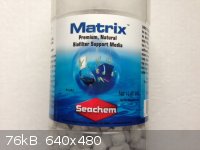 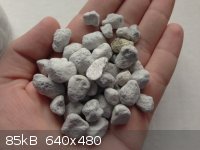
[Edited on 16-12-2012 by Mailinmypocket]
|
|
|
S.C. Wack
bibliomaster
    
Posts: 2419
Registered: 7-5-2004
Location: Cornworld, Central USA
Member Is Offline
Mood: Enhanced
|
|
Assume that nitrification (like everything else, newer members), even on a large scale, has come up here before. (It happens to be convenient that
you're from Quebec.)
|
|
|
plante1999
International Hazard
    
Posts: 1936
Registered: 27-12-2010
Member Is Offline
Mood: Mad as a hatter
|
|
Hmm, could you test if the medium is resistant to acid for me? I found similar stuff that they were calling porous rock for absorbing ammonia but they
were 6$ and I didn't knew there composition. Thanks for the bacteria tip!
I wonder if they would live on activated charcoal.
I never asked for this.
|
|
|
Mailinmypocket
International Hazard
    
Posts: 1351
Registered: 12-5-2011
Member Is Offline
Mood: No Mood
|
|
Quote: Originally posted by plante1999  | Hmm, could you test if the medium is resistant to acid for me? I found similar stuff that they were calling porous rock for absorbing ammonia but they
were 6$ and I didn't knew there composition. Thanks for the bacteria tip!
I wonder if they would live on activated charcoal. |
The porous rock labelled as ammonia remover can vary... There is a product called Am-rid which remove ammonia via absorption as opposed to harboring
bacterial colonies that break it down..
There is also this medium which seems better suited for your needs... You can order it fairly cheap from mops.ca
I suppose I could test acid resistance but how resistant do you need it to be? Let me know the conc. and I will test it out for you
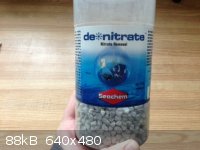 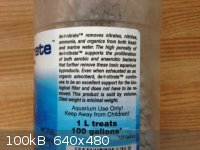
[Edited on 16-12-2012 by Mailinmypocket]
|
|
|
plante1999
International Hazard
    
Posts: 1936
Registered: 27-12-2010
Member Is Offline
Mood: Mad as a hatter
|
|
Quote: Originally posted by S.C. Wack  | | Assume that nitrification (like everything else, newer members), even on a large scale, has come up here before. (It happens to be convenient that
you're from Quebec.) |
I'm not exactly sure I understood this one!
Mailinmypocket, testing with dilute nitric acid, like the bacteria will make.
Since the nitric acid is directly produced on the medium.
I never asked for this.
|
|
|
Mailinmypocket
International Hazard
    
Posts: 1351
Registered: 12-5-2011
Member Is Offline
Mood: No Mood
|
|
Ok- added a piece to some 10% HNO3. No obvious reaction but ill let it sit all day and report back.
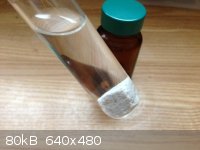
|
|
|
plante1999
International Hazard
    
Posts: 1936
Registered: 27-12-2010
Member Is Offline
Mood: Mad as a hatter
|
|
Good, thanks!
If it is good I will try to find some, however activated carbon would be easier for me. Will one fish air pump would be sufficient for mixing and for
a good colony of bacteria? I will also add calcium carbonate piece to the medium to neutralise the acid produced. The water should have this fallowing
composition:
500 ml H2O
0.5 g FeSO4 (hydrated)
3 g MgSO4 (hydrated)
4 g Na3PO4 (anhydrous)
0.2g KCl
10 ml 30% ammonia
Does that seams right to everybody?
I never asked for this.
|
|
|
S.C. Wack
bibliomaster
    
Posts: 2419
Registered: 7-5-2004
Location: Cornworld, Central USA
Member Is Offline
Mood: Enhanced
|
|
Or inconvenient. Never mind.
|
|
|
plante1999
International Hazard
    
Posts: 1936
Registered: 27-12-2010
Member Is Offline
Mood: Mad as a hatter
|
|
The bacteria doesn't seams to live in the media I told...
I saw that they live on pH 8 so I made a new test with very low ammonia 1 drop of 30% in 100ml sol.
few crystals of Na3PO4 and MgSO4
2 g of NaHCO3 buffer to get the desired pH
So any thought?
I never asked for this.
|
|
|
plante1999
International Hazard
    
Posts: 1936
Registered: 27-12-2010
Member Is Offline
Mood: Mad as a hatter
|
|
The bacteria doesn't seams to live in the media I told...
I saw that they live on pH 8 so I made a new test with very low ammonia 1 drop of 30% in 100ml sol.
few crystals of Na3PO4 and MgSO4
2 g of NaHCO3 buffer to get the desired pH
So any thought?
I never asked for this.
|
|
|
phlogiston
International Hazard
    
Posts: 1379
Registered: 26-4-2008
Location: Neon Thorium Erbium Lanthanum Neodymium Sulphur
Member Is Offline
Mood: pyrophoric
|
|
I also experimented with the Ostwald process a little bit, but never tried any production runs.
I first tried a little loose plug of fine copper wire (from electricity wire) in a 5mm glass tube (pasteurs pipette), and pulled air + ammonia through
with suction. It seemed to work in the sense that the (briefly preheated) copper immediately started to glow brightly and if the NH3 content of the
flow was too high, it quickly melted both the copper wire and the glass tube.
However, I didn't see any brown clouds of NO2, and I wander if I actually got N2 rather than NOx.
NH3 + NO + 1/4 O2 ---> N2 + 3/2 H2O.
When I absorbed the gas in water, it became alkaline rather than acidic.
Perhaps I had an excess of NH3 and got NH4NO3 mostly.
I also tried a little platinum-coated titanium tube (3 mm inner diameter), which yielded essentially the same result and didn't melt, but it is
obviously much more expensive.
-----
"If a rocket goes up, who cares where it comes down, that's not my concern said Wernher von Braun" - Tom Lehrer |
|
|
plante1999
International Hazard
    
Posts: 1936
Registered: 27-12-2010
Member Is Offline
Mood: Mad as a hatter
|
|
Well, copper catalyse the oxidation of ammonia to nitrogen, you would be better to use platinized asbestos like me, platinum ctalyse ammonia oxidation
to NO which oxidize in air to get NO2. I got good results, and cloud of NO2.
For the biochemical preparation:
I made a nitrite test solution by hydrolysing 0.1g of paracetamol which 3 ml of Conc. HCl in 20 ml of water. Then I tryed my test solution on a
premade nitrite solution. I put one crystal of sodium nitrite in 100ml of water. I took 2 small sample of the solution, in one I added ammonia. Then I
added one drop of the test solution and both become yellow. I also tested the test solution in distilled water but the solution didn't changed color,
prouving that my test solution was working. Then I tryed the test solution on a sample of my biochemical medium after 2 hour of run. No nitrite was
detected.
So I checked the pH and it was 10. Since bacteria are supposed to grow in pH of 7-8 I made a New medium.
Does someone have a new medium composition for the colony? At the moment the bacteria lives in activated carbon.
[Edited on 16-12-2012 by plante1999]
I never asked for this.
|
|
|
Mailinmypocket
International Hazard
    
Posts: 1351
Registered: 12-5-2011
Member Is Offline
Mood: No Mood
|
|
Just an update:
The support media I have tested today with ~10% HNO3 shows no signs of degradation. Air escapes at first and when swirled for the first couple times
there was a slight sediment that stirred up. I boiled it for one minute and let it sit another couple hours. No visible damage... I didn't bother
drying the sample, exposing to acid, rinsing and re-drying since this was just a crude test. But I think you would be good to go with something like
this product.
This might be a thread better suited to biochemistry by the way!
[Edited on 17-12-2012 by Mailinmypocket]
|
|
|
plante1999
International Hazard
    
Posts: 1936
Registered: 27-12-2010
Member Is Offline
Mood: Mad as a hatter
|
|
I agree, thanks for the try but Now I'm in the problem of making a LIVING colonies, it seams I do something wrong... As it doesn't seams to have
anything living.
First I guess a 500 ml to 1L reaction vessel would be better. Than I would need to know a "recipe" for a good medium. I have hard time trying to make
a living colonie.
I never asked for this.
|
|
|
Mailinmypocket
International Hazard
    
Posts: 1351
Registered: 12-5-2011
Member Is Offline
Mood: No Mood
|
|
Quote: Originally posted by plante1999  | I agree, thanks for the try but Now I'm in the problem of making a LIVING colonies, it seams I do something wrong... As it doesn't seams to have
anything living.
First I guess a 500 ml to 1L reaction vessel would be better. Than I would need to know a "recipe" for a good medium. I have hard time trying to make
a living colonie. |
What you might want to try is keeping one fish (gold fish work fine) in a small tank with a simple filter. Let it go for a while until you can collect
scum from inside the filters. Use this material to colonize your media. Having a live ecosystem to collect bacteria/cultures from is far better than
starting straight off with those supplements. IMO.
|
|
|
plante1999
International Hazard
    
Posts: 1936
Registered: 27-12-2010
Member Is Offline
Mood: Mad as a hatter
|
|
Would activated carbon work as the filter?
Anyway I think ammonium salt would be better then ammonia, since I'm always bufering the media after each ammonia drop. Any thought for the ammonium
salt?
I'm starting to think that calcium carbonate have serious advantage. A medium with calcium carbonate on the bottom and adding ammonium salt to it,
maybe even urea would be good.
The ammonium salt/urea doesn't interfere with the pH but when pH get low the calcium carbonate react with HNO3 to get about a pH 7 to 8. Then there is
the medium that migth help, activated charcoal migth not be the best house for the colonies.
I would also like to know how I could test for living bacteria.
I never asked for this.
|
|
|
MagicJigPipe
International Hazard
    
Posts: 1554
Registered: 19-9-2007
Location: USA
Member Is Offline
Mood: Suspicious
|
|
"I would also like to know how I could test for living bacteria. "
Errrr... A petri dish and a microscope...
"There must be no barriers to freedom of inquiry ... There is no place for dogma in science. The scientist is free, and must be free to ask any
question, to doubt any assertion, to seek for any evidence, to correct any errors. ... We know that the only way to avoid error is to detect it and
that the only way to detect it is to be free to inquire. And we know that as long as men are free to ask what they must, free to say what they think,
free to think what they will, freedom can never be lost, and science can never regress." -J. Robert Oppenheimer
|
|
|
phlogiston
International Hazard
    
Posts: 1379
Registered: 26-4-2008
Location: Neon Thorium Erbium Lanthanum Neodymium Sulphur
Member Is Offline
Mood: pyrophoric
|
|
Normally, in microbiological work, you sterilize your medium first and then inoculate with the desired species. If you don't you will get all sorts of
'wild' bacteria and fungi that will compete with your nitrificating bacteria and may take over. And it is actually quite tough to keep a culture from
being infected with other species for extended periods of time, unless the conditions are so unusual that they greatly favour the desired bacterium
over other species.
Edit: The simplest way to test for viable bacteria is to plate them onto a slab of solidified medium (using agar-agar) in a petri dish and allow them
to grow. You should then be able to count the colonies (each of which sprouted from a single viable cell, if you diluted the sample sufficiently).
[Edited on 17-12-2012 by phlogiston]
-----
"If a rocket goes up, who cares where it comes down, that's not my concern said Wernher von Braun" - Tom Lehrer |
|
|
| Pages:
1
2 |